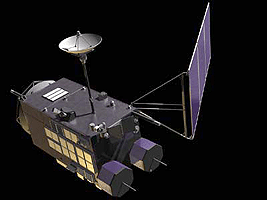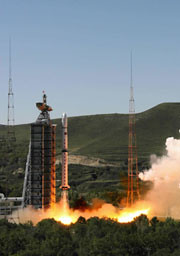Archive for September, 2007
Work on Warp Drive
Friday, September 21st, 2007
We blogged about getting a space job before, but now it looks like a few hundred can call their new business address "Warp Drive." That’s right: Warp Drive is an "inside" street name on the corporate campus Orbital Sciences, a company that’s about to expand in Northern Virginia, according to the Washington Post:
Orbital Sciences, a rocket and space technology manufacturer for the government and military, is embarking on a major expansion of its headquarters in Dulles, adding as many as four buildings and about 600 jobs to its campus.
The company’s 77-acre campus along Route 28 employs 1,500 workers. More than 100 employees work at leased office space a few miles down the road, and Orbital continues to grow. To date, the company said it has $4 billion worth of backlogged contracts.
"Orbital’s business is doing extremely well and growing quite rapidly," said Barron Beneski, a company spokesman.
The buildings — totaling 140,000 square feet — will house office, engineering and manufacturing space on an undeveloped tract of land adjacent to the campus. Construction on the first building has been approved by Loudoun County and is scheduled to begin in early 2008. The first new employees could occupy the space in 2009.
"The next several years we will build buildings as the need arises," Beneski said.
The federal government is Orbital Sciences’ biggest customer. The satellite company has contracts with the Defense Department and military intelligence agencies.
Space flight, in particular, is fueling much of Orbital Sciences’ growth, Beneski said. In 2010 NASA plans to retire the Space Shuttle. The company is part of a team led by Lockheed Martin that is producing the next generation of manned spacecraft to launch astronauts to the moon and beyond. The company stands to make $450 million to $500 million over the next 12 years from its role in the program.
Orbital also manufactures commercial communication satellites for companies such as Intelsat and SES Global.
"In the Washington area, there’s not a whole lot of manufacturing going on," Beneski said. "Consultants and IT people produce a lot of paper and gigabytes. We actually produce real stuff."

DIY Friday: A Hard Drive Clock
Friday, September 21st, 2007Hack a Day points us to today’s DIY Friday project: a hard drive clock that uses the actual drive mechanism and heads to keep track of time (as opposed to simply a regular clock mechanism with a recycled hard drive face).

Instructions can be found here. Don’t sprechen Deutsche? Google can translate:
The synchronous motor, which propels the magnetic disks, engages in 16 positions per revolution dead magnetically. 12 positions are used thereby as hour announcement, after 12 o’clock must run the engine of 5 steps further, in order to continue again with 1 o’clock. The write/read head, which is propelled with a stepping motor, engages likewise dead magnetically. It is used, in order to indicate the minutes within one hour. Beginning of the internal point it moves within one hour to the outside edge of the magnet disk.
Since it’s German, you can rest assured that your DIY project will run on time, but you’ll want to use the atomic clock at Fort Collins to set the clock correctly. (Consistency with errors creates consistent error.)
Also be sure to check out this very cool video of another hard drive clock. (It’s available on YouTube, but embedding is disabled for this particular video.)
If all of this seems a bit too complicated for you, for $5 you can make a Salvador Dali melting clock — but obviously, without hard drive parts.
Brazilian Observation Satellite Launched by Chinese
Thursday, September 20th, 2007
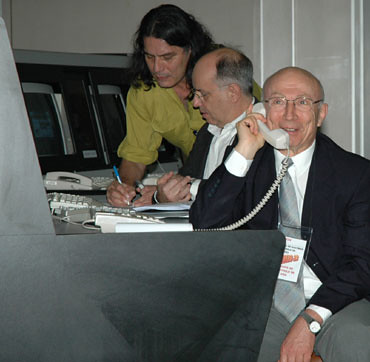
There are a lot of happy rocket scientists in Brazil today:
CBERS-2B é lançado com sucesso da base chinesa de Taiyuan
Exatamente às 00h26min desta quarta-feira (19) foi lançado com sucesso o CBERS-2B, terceiro satélite da parceria entre Brasil e China. O evento foi comemorado tanto no Centro de Controle de Satélites do INPE, em São José dos Campos (SP), como no Centro de Lançamento de Satélites de Taiyuan. O diretor do INPE, Gilberto Câmara, assistiu ao lançamento na base chinesa e, junto com os engenheiros Ricardo Cartaxo e Jânio Kono, respectivamente coordenador geral e coordenador do Segmento Espacial do Programa CBERS, transmitiu todas as informações aos técnicos e convidados que acompanharam da sede do Instituto.
“É uma emoção muito grande. É o resultado de um grande trabalho feito por brasileiros e chineses. Estamos todos muito orgulhosos”, disse o diretor Gilberto Câmara.
Chefe do Centro de Controle de Satélites do INPE, Pawel Rosenfeld manteve contato constante com Jânio Kono, coordenador do Segmento Espacial do Programa CBERS, que da base comandou as operações junto com os técnicos chineses.
O foguete Longa Marcha 4B cumpriu perfeitamente todas as etapas previstas para colocação do satélite em órbita. O tempo total de vôo até a injeção do CBERS em órbita foi de 12,5 minutos. O CBERS-2B é lançado com seus transmissores ligados permitindo assim que a estação de rastreio de Nanning, na China, mantenha contato com o satélite desde antes de sua separação do último estágio do veículo lançador, até aproximadamente um minuto e meio após a abertura dos painéis solares, que aconteceu cerca de 14 minutos após o lançamento.
The spacecraft is capable of producing images such as this beauty of Manaus:

Here’s the explanation, in English, via SpaceFlightNow.com:
A joint mission developed by China and Brazil was shot into an orbit circling Earth’s poles to snap detailed images of the globe during an early Wednesday launch from China’s northeastern space base.
A Long March 4B rocket launched with the international satellite at 0326 GMT Wednesday (11:26 p.m. EDT Tuesday) from the Taiyuan space center in China’s Shanxi province, according to the state-run Xinhua news agency.
The booster’s three liquid-fueled stages accurately deposited the third China-Brazil Earth Resources Satellite into a Sun-synchronous orbit about 12 minutes after liftoff.
CBERS 2B was left in a nearly circular orbit with an average altitude of approximately 462 miles, Xinhua reported. The Long March 4B was shooting for an orbital inclination of 98.5 degrees.
Wednesday’s launch marked the 60th consecutive success for China’s Long March rocket fleet. It was also the 8th space launch for China so far this year.
CBERS 2B will spend the next few weeks undergoing systems tests and preparations for an operational mission expected to last at least two years.
The 3,200-pound satellite was ordered by Chinese and Brazilian officials in 2004 to bridge the gap between older spacecraft and next-generation satellites, which should begin launching in 2009.
The craft’s predecessors, CBERS 1 and CBERS 2, were launched by Chinese rockets in 1999 and 2003, respectively. Both outlived their baselined two-year missions, according to Brazil’s National Institute for Space Research, a co-sponsor of the program.
The China Academy of Space Technology was in charge of the Chinese contribution to the mission, Xinhua reported.
CBERS 2B carries three primary imaging cameras to take a wide range of pictures of locations scattered throughout the world.
A low-resolution camera with a 60-degree field of view will specialize in capturing images of large swaths of the planet. Another camera will be capable of taking pictures with a resolution of about 65 feet.
Unlike its forerunners, CBERS 2B includes a high-resolution black-and-white camera able to produce images showing objects as small as 2.5 meters, or about eight feet. CBERS 1 and CBERS 2 each carried an infrared scanning instrument instead.
Scientists expect to use data from the project in environmental monitoring, crop planning and managing water resources. Images can also be used to identify types of vegetation and in soil surveys. Pictures could also end up in geography textbooks, according to Brazilian space officials.
Images from the new high-resolution camera will also be useful in urban planning and military intelligence applications for China and Brazil.
China has a 70 percent stake in the 19-year-old program, while Brazil controls about 30 percent of the project. Users in both nations have access to the satellite imagery.
Pictures from the spacecraft have been distributed online since 2004, and more than 15,000 users have downloaded about 320,000 images since the Internet campaign began, according to Brazilian officials.
Two more satellites with four cameras each will be launched in 2009 and 2011. The program extension was approved in 2002, and China and Brazil will equally split responsibility for the new project.
Here’s a video about the Brazilian Space Agency:
And here’s a little Brazilian space center tribute video set to Brazilian metal (mind the volume):
SeaMobile Testing VSAT Over Atlantic
Wednesday, September 19th, 2007We’ve written before about the growing market for maritime satcom for large ships. Now, SES NEW SKIES is teaming up with SeaMobile’s Maritime Telecommunications Network (MTN) product group for extensive field tests of new miniaturized VSAT antennas, which will enable an array of satellite-based communications services for small vessels:
SeaMobile and SES NEW SKIES will test two new 60cm VSAT antennas, that set new standards with respect to size and weight of VSAT installations: the heavy-duty “Ruggidized” for fishing, work boats and oceangoing support vessels, and the lighter “Sure Lock”, which at less than 90lbs addresses more specifically the sailing, yachting and power boat markets. Both antennas use iDirect Spread Spectrum technology, allowing for small-sized, lightweight antennas which are effectively shielded against adjacent satellite interference. SES NEW SKIES is providing Ku-band capacity for the Spread Spectrum Technology demonstrations on its NSS-7 satellite at the orbital location of 338° East….
States Scott Sprague, Senior Vice President Global Sales of SES NEW SKIES: “Small-sized and light-weight VSAT antennas open up completely new markets for small vessel broadband connectivity, be it for professional use, navigation support, safety services or pure leisure/entertainment. The SES NEW SKIES global satellite fleet is particularly well positioned to support communications on the move, be it maritime, land- or air-based.”
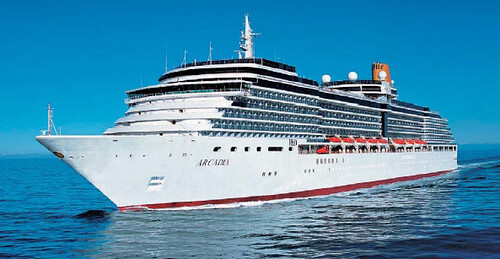
As you can see from this map, SeaMobile currently has extensive MTN satellite coverage, and they’ve just signed their first commercial shipping customer:
SeaMobile Enterprises, a provider of at-sea communications and connectivity, announced Tuesday that it has reached a service agreement with Global Marine Systems, an independent, undersea cable installation and maintenance company. Terms of the three-year contract were not disclosed. SeaMobile said it will provide its Maritime Telecommunications Network satellite services aboard three Global Marine vessels. SeaMobile said it has already installed its MTN VSAT satellite services on two of the ships and expects to address the third later this month. Global Marine Systems is based in Chelmsford, England. SeaMobile is headquartered in Seattle and provides broadband and satellite services for more than 300 maritime vessels.
Stratos has also recently entered the maritime satcom marketplace, while Schlumberger is working to build a model that integrates land and sea.
Delta Launches WorldView-1
Wednesday, September 19th, 2007Google Earth users may soon be enjoying higher-resolution images of our little blue planet, thanks to yesterday’s launch of the Worldview 1 satellite.
The AP gives a summary:
The WorldView 1 satellite, built for DigitalGlobe, which supplies much of Google Earth’s imagery, was lofted into space aboard a Delta 2 rocket [from Vandenberg Air Force Base]. The satellite separated from the rocket about an hour after liftoff and was circling 300 miles (480 kilometers) above Earth.
WorldView 1 was designed to collect up to 290,000 square miles’ (750,000 square kilometers’) worth of imagery a day — an area about the size of Texas. Information gathered by the 5,000-pound (2,270-kilogram) probe can be used by governments and companies to assess damage after a natural disaster or plan escape routes before a catastrophe, the company said.
Images and details about the bird can be found on the DigitalGlobe website. Features include an "ultra-stable platform, high-precision attitude sensors and GPS" that "allows the creation of accurate maps in remote areas, maximizing the utility of whatever resources are available," as well as the "highest commercially available" resolution, with direct downlink of those images available to customer sites using a high-speed 800 Mbps X-band downlink.

The Worldview 1 satellites was built by Ball Aerospace. Check out their online media kit, including high-resolution photos of the satellite.
Worldview 2, also being built by Ball Aerospace, is slated for completion in late 2008.
Home Run Ball in Space
Tuesday, September 18th, 2007
The guy who owns Barry Bonds’ record-breaking home run ball may send it into space. Voting ends on 25 September 2007:
I have my own opinion, I’ve been part of this debate just like everyone else. But I wanted to make it just a little more real. I bought this baseball to democratize the debate over what to do with it.
So what should we do with the ball? (A) Bestow it — Cooperstown; (B) Brand it — burn an asterisk into the ball, adding a permanent footnote to the record, then Cooperstown; or (C) Banish it — put the ball on a rocket ship and launch it inot orbit, a moon shot for the ages.
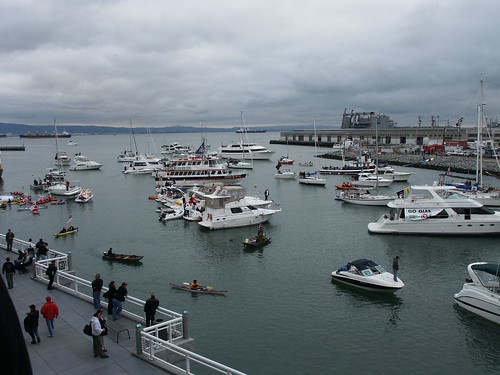
Alaska Airlines – another first?
Tuesday, September 18th, 2007If you’d ask a group of passengers if cell-phone calls should be allowed on flights, you would receive instant protest. No one wants to sit next to a chatterbox teenager or, worse, an angry business man with a bluetooth for a five hour flight. You ask about WiFi, however, and you would receive instant excitment. Emails, surfing, news, chatting — Americans want to be connected.
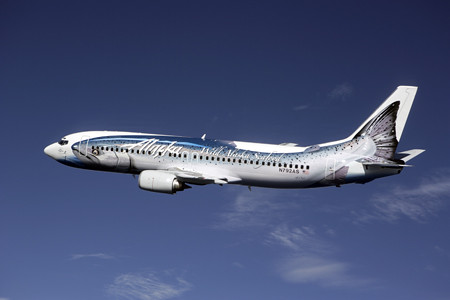
As the airline biz gets increasingly competitive, is inflight Internet access the next competitive edge? Alaska Airlines thinks so:
Alaska Airlines today announced it plans to launch inflight wireless Internet service next year based on Row 44’s satellite-based broadband connectivity solution. Alaska made the announcement in Toronto at the 28th Annual World Airline Entertainment Association Conference and Exhibition. The airline will test Row 44’s system on a next-generation Boeing 737 aircraft in spring 2008 and, based on the trial’s outcome, plans to equip its 114-aircraft fleet.
The technology will provide customers with a unique entertainment and business network at 35,000 feet. Passengers with Wi-Fi-enabled devices, such as laptop computers, PDAs, smartphones and portable gaming systems, will have high-speed access to the Internet, e-mail, virtual private networks and stored inflight entertainment content.
“Bringing broadband Internet access to the skies is one of the most important things we can do to enhance the experience of both business and leisure customers,” said Steve Jarvis, Alaska Airlines’ vice president of sales, marketing and customer experience. “We’re moving ahead with testing and ultimately plan to bring wireless broadband to our whole fleet.”
Unlike air-to-ground services, Row 44’s satellite-based system is designed to function over land, water and across international borders, enabling service throughout Alaska’s route system in Alaska, the Lower 48 states, Hawaii, Canada and Mexico.
Customers connect to the system through wireless hotspots installed inside the aircraft cabin. A light-weight radome mounted on top of the aircraft houses an antenna, which receives and transmits signals through the Ku-band satellite system.
Alaska plans to become the first US airline with such connectivity, although American and Virgin America are planning similar services through an air-to-ground platform provided by AirCell. Row 44’s system will rely on high-earth-orbit satellites, providing continuous coverage in remote areas and over water (it is Alaska Airlines, after all). Both systems can be easily installed in short sessions, lessening the aircraft down-time.
Alaska has a history of innovation. They were the first North American airline to offer online ticketing (1995) and online check-in (1999). Oh, and they paint salmon on some of their planes. Cool.
If history is our guide, similar in-flight Internet platforms will be picked up by other carriers in short-order. The WSJ (subcription-only) mentions that Southwest is considering the service. And the always active rumor-mill at Airliners.net is predicting a big JetBlue announcement in October (inflight Internet, perhaps?).
Sealand – a communications hub?
Monday, September 17th, 2007We’ve discussed a lot of important deployments of satellite Internet — developing nations, rural areas, and mobile platforms, to name a few. Let’s not forget about MicroNations: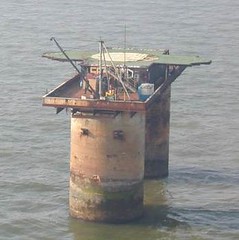
Sealand, a tiny ex-British military base used during WWII, sits just off the Southeast coast of England. Since the tiny platform has only a population of 20, no connections to mainland England, and, um, questionable international status, how does Sealand get wired?
From SatNews:
The Principality of Sealand has received a multi-million dollar investment opportunity from a Russian investment group to fund the launch of a new communications satellite. So states the official newspaper of the country, the Sealand News. Such a project would give the independent micro-nation total worldwide Internet freedom plus internationally un-restricted Internet broadcasting, all from the former military fortress/artificial island located six miles off the coast of Britain.
It’s no secret why Sealand would be an attractive communications hub — no taxes, no censorship, no restrictions. For example, Sealand will soon be launching an online casino, promising 100% tax-free winnings. There has also been talk of using Sealand as a hub for media download services.
Pirate Radio is on the list too. Sealand’s own newspaper has the details:
A new Pirate Radio Station is supposed to set up shop in Sealand.
History repeats itself as a group of young radio DJs are negotiating with the Principality over using the former British anti-aircraft platform as the location for their new “Free Radio Sealand”.
Plans are to use the facilities of HavenCo, the internet hosting company with its datacenter located in Sealand, to launch an international internet radio station as well as a terrestrial and digital radio station.
“We’re going to bring back Pirate Radio big time,” said Stuart Turner (21), also known as Lord Stuart of Sealand, a former Virgin Radio DJ. “We’re going back to the roots of Radio Essex when listening to the radio was actually a way of life!”
The Principality of Sealand used to be a Pirate Radio station in the early Sixties: During the summer of 1965 Roy Bates entered the Pirate Radio business and set up his own radio station at Knock John Tower, a former WW2 British naval defence platform in the Thames estuary.
An original wartime radio beacon was converted for use as the broadcasting transmitter and regular broadcasts commerced on 7 November 1965. The enormously popular Radio Essex, later renamed BBMS (Britain’s Better Music Station) was the first Pirate Radio Station to provide 24/7 entertainment and shaped the face of Sixties pop culture as we remember it.
After being convicted of violating British broadcasting law, Roy Bates moved his radio station to Roughs Tower. 2 years later Bates turned Roughs Tower into the Principality of Sealand and became HRH Prince Roy of Sealand!
KAGUYA Launches
Monday, September 17th, 2007In June, we discussed the naming of Japan’s new lunar study — what many consider the most sophisticated lunar exploration mission in the post-Apollo Era. It is also Japan’s first major lunar mission. Last Friday morning, the spacecraft launched from Tanegashima island, 600 miles south-west of Tokyo, aboard an H-2A solid-fuel rocket:
ScienceDaily has the project details:
The mission of the SELenological and ENgineering Explorer “KAGUYA” (SELENE), Japan’s first large lunar explorer, is being keenly anticipated by many countries.
The major objectives of the mission are to understand the Moon’s origin and evolution, and to observe the moon in various ways in order to utilize it in the future. The lunar missions that have been conducted so far have gathered a large amount of information on the Moon, but the mysteries of its origin and evolution have been left unsolved.
KAGUYA will investigate the entire moon in order to obtain information on its elemental and mineralogical composition, its geography, its surface and sub-surface structure, the remnant of its magnetic field, and its gravity field. The results are expected to lead to a better overall understanding of the Moon’s evolution.
At the same time, the observation equipment installed on the orbiting satellite will observe plasma, the electromagnetic field and high-energy particles. The data obtained in this way will be of great scientific importance for exploring the possibility of using the moon for human endeavors.
KAGUYA consists of the Main Orbiter and two small satellites (Relay Satellite and VRAD Satellite). The Main Orbiter will reach the vicinity of the Moon. Once it has reached the Moon, it will be placed into a peripolar orbit at an altitude of 100 km. The Relay Satellite will be placed in an elliptic orbit at an apogee of 2400 km, and will relay communications between the Main Orbiter and the ground station. The VRAD Satellite will play a significant role in measuring the gravitational field around the Moon. The Main Orbiter will be employed for about one year and will observe the entire Moon.
Is this the start of an Asian Space Race? The Guardian sees some evidence:
While Jaxa officials play down talk of a space race with China, the mission is a major step towards the goal of building a manned station on the moon by 2025, and a sign of renewed regional interest in lunar exploration. China is to send its Chang’e-1 probe to the moon this year to construct 3-D images of the moon’s surface and analyse its dust. India is expected to launch an unmanned lunar orbiter next year.
